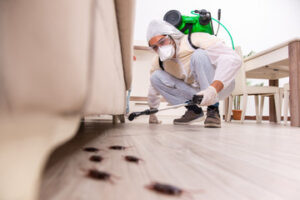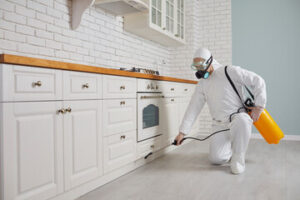Using their skills, they help customers understand and manage pests. This may involve educating them on sanitation practices, structural repairs, and landscaping changes that can minimize pest attractants and entry points.

Many people envision exterminators in hazmat suits spraying their way through a house, but that is not always the case. In fact, pest control is a lot more sophisticated than that. Contact Exterminator Vancouver BC for professional help.
Pest identification is the first step in any pest management strategy. Accurately identifying a pest can help a Rentokil technician develop the most effective solution for your commercial property. Pests can look very different at various stages of their life cycle or during certain times of the year. In addition, some pests share similar physical characteristics with non-pests and beneficial organisms.
Incorrect pest identification can result in a failed control attempt. For example, if you incorrectly identify an insect as tent caterpillars but it actually is spruce budworms, a product that targets the wrong species will not work.
Identifying a pest correctly allows you to use more targeted, non-chemical pest control methods. This is important because it can prevent the unnecessary use of chemicals that can damage healthy plants and other organisms, as well as reduce the risks to people and pets.
The best way to identify a pest is with the help of an expert. A specialist can provide a precise diagnosis and recommend treatment strategies that will eliminate the pest without harmful impacts to natural or cultural resources. In addition, proper identification can help to ensure that the right pesticide is used – for instance, approved biological insecticides (such as Bacillus thuringiensis) require accurate species-level identification to ensure the correct strain of the bacteria is delivered to the target insects.
For vertebrate pests, an online identification tool can help narrow down the potential culprit based on typical damage, tracks and droppings. This information can then be compared to a database of photographs, biology and other pertinent details that are available to help determine the correct identification.
Many museum pests have multiple life stages that can be difficult to distinguish from one another. For example, pantry moths and golden spider beetles both feed on a wide range of foods but the identifying characteristic is the silky webbing that covers food items in these cases. In addition, it is often helpful to start a file of labelled digital images that can be referenced for future inspections. This helps to improve the accuracy of insect scouting data and predict when key pests will be present for IPM planning purposes.
Pest Prevention
Pest prevention focuses on reducing the ability of pests to gain access to homes. This involves keeping indoor and outdoor spaces clean and eliminating their food, water and shelter sources. While this does not eliminate every pest, it can significantly reduce the amount of time a pest is inside and the number of pests in an area.
Some pests can transmit diseases that affect human health, such as hantavirus (transmitted by rodent droppings) and fleas and ticks that may carry parasites like lice or mites. Others damage property, including wood-destroying termites and cockroaches. Routine pest control can protect a home’s structure and furniture from damage, preserve its value and help prevent costly repairs or replacements.
Using pest-repelling materials, sealing cracks and crevices and preventing the entry of moisture and light are all part of pest prevention. In addition, regular cleaning and inspection can reduce the need for insecticides. For example, sweeping up food spills immediately after they occur and storing outdoor garbage receptacles away from the house, ensuring their lids fit securely can prevent pests. Store firewood in a shed or in the garage, not next to or in close proximity to the house and keep yard grass trimmed and free of weeds and debris.
A pest management program allows facility, property and QA managers to better manage their risk by creating a plan of attack for preventing pests at the start rather than responding after they have become a problem. This requires a bigger investment of time, people and resources on the front end but once in place it becomes second nature and lowers a facility’s pest exposure.
A well-established pest prevention program should include a thorough inspection at least once a year, which will identify and correct problems before they become an infestation. It should also include the use of pest-repelling products such as door sweeps, sealants and expanding joints as well as the use of baits and traps for cockroaches and ants. In addition, it should also incorporate integrated mosquito control through larviciding and fogging. These strategies are more effective than using insecticides in and around the home, which can be harmful to pets and children and that may also cause environmental concern.
Pest Treatment
As pests invade your home and cause damage, a treatment from a professional is necessary to regain control. Pest treatments are a reactive approach to pest control that includes both the use of insecticides and physical traps to address infestations as they occur.
The first step in any treatment plan is a thorough inspection. This allows a trained pest control technician to identify entry points, nesting areas, and signs of pest activity. The findings of the inspection will then be used to develop a customized pest control plan for your property. This may include spraying, baiting, dusting, or trapping, depending on the type of pest, its severity, and the location.
A pest species is any organism that humans deem undesirable due to their impact on human activities and/or quality of life. Pests can be plants, insects, weeds, rodents, or even disease vectors. While a pest is not necessarily a nuisance, the term “nuisance” refers to any species that disrupts human activities or causes discomfort.
Once a pest problem is identified, an appropriate pest management strategy must be implemented to reduce the number of pests to an acceptable threshold. This threshold is defined as the number below which additional costs of controlling the pests exceed the benefits gained by doing so. Pest control methods can be divided into four categories: chemical, biological, cultural, and physical/mechanical.
Chemical control uses synthetic or organic substances to kill or repel unwanted pests. These can range from aerosol bug sprays to liquid insect killers and are often combined with other products for optimal results. The most important consideration in any application of chemicals is ensuring personal safety. Proper PPE, such as long sleeves, pants, closed-toe shoes, face and eye protection, and proper ventilation, is essential for safe handling of any product.
When addressing pests, a combination of pest prevention and treatment is usually the best approach. In fact, preventative pest management is key to a healthy home that’s free of unwelcome guests. In addition to practicing prevention tips, a treatment from a pest control expert can help eliminate current infestations and keep pests away for good.
Post-treatment Care
Once the pests have been eliminated, you must take preventive steps to keep them from returning. This includes sealing entry points and deep cleaning your space to clear away any coating of chemicals or additives utilized in the extermination process.
Before the exterminators come, make sure to store food in heavy plastic containers to ensure that nothing gets sprayed during the process. It is also wise to put away clothing, children’s toys, jewellery and utensils to protect them from solvent sprays used in the process.
Wait until the exterminator tells you that it is safe to re enter your home. This will allow your family and pets to enjoy the results of the treatment and help you to prevent pests from returning. Green treatments may require less wait time, but always follow your exterminator’s instructions and product specific guidance.
